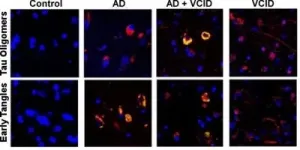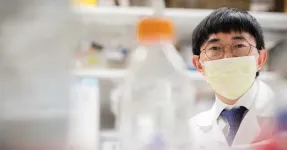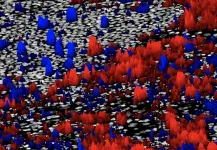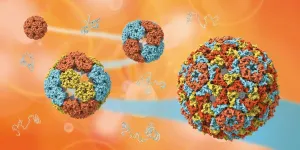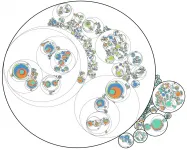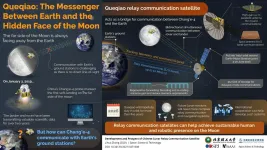(Press-News.org) Researchers remain perplexed as to what causes dementia and how to treat and reverse the cognitive decline seen in patients. In a first-of-its-kind study, researchers at the Medical University of South Carolina (MUSC) and Beth Israel Deaconess Medical Center (BIDMC), Harvard Medical School discovered that cis P-tau, a toxic, non-degradable version of a healthy brain protein, is an early marker of vascular dementia (VaD) and Alzheimer's disease (AD). Their results, published on June 2 in Science Translational Medicine, define the molecular mechanism that causes an accumulation of this toxic protein. Furthermore, they showed that a monoclonal antibody (mAb) that targets this toxic protein was able to prevent disease pathology and memory loss in AD- and VaD-like preclinical models. Additionally, this treatment was even capable of reversing cognitive impairment in an AD-like preclinical model.
"We believe our findings have not only discovered cis P-tau as a previously unrecognized major early driver of VaD and AD but also identified a highly effective and specific immunotherapy to target this common disease driver for treating and preventing AD and VaD at early stages," said Onder Albayram, Ph.D., co-lead author and assistant professor in the Division of Cardiology in the Department of Medicine at MUSC.
Aging is a normal part of life - we experience weakening of our bones and muscles, stiffening of our blood vessels and some memory lapses. But for around 50 million people worldwide, these memory lapses become progressively more severe, ultimately leading to a diagnosis of dementia.
Dementia is an umbrella term that covers AD, which accounts for 60% to 80% of cases; VaD, the second most common cause; and other less common pathologies. Currently, there are no effective treatments for AD. Interestingly, most AD cases have a vascular component, suggesting a broader relationship between cognitive function and healthy brain vasculature. A better understanding of that relationship could provide a platform to discover novel therapeutic targets.
"Our work provides evidence that cis P-tau may be a pathogenic factor that explains VaD, which is not generally linked to other dementias," added Chenxi Qiu, Ph.D., co-lead author and a postdoctoral research fellow at BIDMC, Harvard Medical School.
In a preclinical model of VaD, young mice showed signs of brain inflammation and memory loss within one month. However, treating these mice with the cis P-tau mAb prevented neural degradation and cognitive decline out to six months. In a separate preclinical model of AD, old mice showed severe cognitive impairment. Excitingly, this severe impairment was significantly reversed when mice were given the cis P-tau mAb.
"These data show that cis P-tau could be an early upstream pathogenic factor common to both diseases," said Albayram.
Translating information gained from preclinical models to humans is often difficult, but this study offers reasons to be optimistic. Accumulation of cis P-tau caused dramatic changes in the genetic architecture of affected cells in a VaD model; these changes were consistent with those seen in human AD patients. The researchers went on to show that treatment with the cis P-tau mAb reversed 85% to 90 % of those changes suggesting the power of this potential therapy.
"The genomic landscape really adapts after the silencing of this toxic protein," said Albayram. "That was a big discovery."
Not only are Albayram and Qiu excited about these findings, but colleagues at MUSC are already quite enthusiastic about this work.
"I can go on and on about this paper," said Adviye Ergul, M.D., Ph.D., professor in the College of Medicine, Department of Pathology and Laboratory Medicine at MUSC. "They provide robust evidence that there is accumulation of a specific form of the tau protein - cis P-tau - that highlights a different tau protein pathology in VaD research."
This groundbreaking research has opened the door for new potential immunotherapies and highlighted several new areas of research that need to be explored. While the researchers delineated a pathway that leads to the accumulation of cis P-tau, the underlying linkage between vascular abnormalities and activation of the pathway needs to be identified. A better understanding of how toxic cis P-tau interacts with the healthy trans P-tau could provide further insights into the progression of AD disease.
AD and VaD might not be the only diseases affected by high levels of cis P-tau. Other brain disorders with a vascular component might also arise from this toxic protein, but further study will be required to establish such a link.
"Cis P-tau may be a common, early and pathogenic factor underlying traumatic brain injury, VaD and AD," said Qiu.
As we get older and our memory begins to lapse - misplacing our car keys or forgetting the name of a new acquaintance - we fear the possibility that these are the first signs of dementia. And while there is currently no approved treatment to reverse the physiological effects of dementia, this new research may provide hope that new therapies are around the corner.
INFORMATION:
About MUSC
Founded in 1824 in Charleston, MUSC is home to the oldest medical school in the South as well as the state's only integrated academic health sciences center, with a unique charge to serve the state through education, research and patient care. Each year, MUSC educates and trains more than 3,000 students and nearly 800 residents in six colleges: Dental Medicine, Graduate Studies, Health Professions, Medicine, Nursing and Pharmacy. MUSC brought in more than $271 million in biomedical research funds in fiscal year 2020, continuing to lead the state in obtaining National Institutes of Health funding, with more than $129.9 million. For information on academic programs, visit musc.edu.
As the clinical health system of the Medical University of South Carolina, MUSC Health is dedicated to delivering the highest quality patient care available while training generations of competent, compassionate health care providers to serve the people of South Carolina and beyond. Comprising some 1,600 beds, more than 100 outreach sites, the MUSC College of Medicine, the physicians' practice plan and nearly 275 telehealth locations, MUSC Health owns and operates eight hospitals situated in Charleston, Chester, Florence, Lancaster and Marion counties. In 2020, for the sixth consecutive year, U.S. News & World Report named MUSC Health the No. 1 hospital in South Carolina. To learn more about clinical patient services, visit END
WACO, Texas (June 9, 2021) - Most people listen to music throughout their day and often near bedtime to wind down. But can that actually cause your sleep to suffer? When sleep researcher Michael Scullin, Ph.D., associate professor of psychology and neuroscience at Baylor University, realized he was waking in the middle of the night with a song stuck in his head, he saw an opportunity to study how music -- and particularly stuck songs -- might affect sleep patterns.
Scullin's recent study, published in Psychological Science, investigated the relationship between music listening and sleep, focusing on a rarely-explored mechanism: involuntary musical imagery, or "earworms," when a song or tune replays ...
June 10, 2021, CLEVELAND: A new Cleveland Clinic-led study has identified mechanisms by which COVID-19 can lead to Alzheimer's disease-like dementia. The findings, published in Alzheimer's Research & Therapy, indicate an overlap between COVID-19 and brain changes common in Alzheimer's, and may help inform risk management and therapeutic strategies for COVID-19-associated cognitive impairment.
Reports of neurological complications in COVID-19 patients and "long-hauler" patients whose symptoms persist after the infection clears are becoming more common, suggesting that SARS-CoV-2 (the virus that causes COVID-19) may have lasting effects on brain function. However, it is not yet well understood how the virus leads to neurological issues.
"While some studies suggest ...
The human heart contracts about 70 times per minute, while that of a rat contracts over 300 times; what accounts for this difference? In a new study publishing 10th June in the open-access journal PLOS Biology, led by Michael Geeves and Mark Wass of the University of Kent and Leslie Leinwand from the University of Colorado Boulder, reveal the molecular differences in the heart muscle protein beta myosin that underly the large difference in contraction velocity between the two species.
Myosin is a "molecular motor" - an intricate nanomachine that forms the dynamic core of a muscle's contractile machinery, burning ...
Pairing sky-mapping algorithms with advanced immunofluorescence imaging of cancer biopsies, researchers at The Mark Foundation Center for Advanced Genomics and Imaging at Johns Hopkins University and the Bloomberg~Kimmel Institute for Cancer Immunotherapy developed a robust platform to guide immunotherapy by predicting which cancers will respond to specific therapies targeting the immune system.
A new platform, called AstroPath, melds astronomic image analysis and mapping with pathology specimens to analyze microscopic images of tumors.
Immunofluorescent imaging, using antibodies with fluorescent tags, enables researchers to visualize multiple cellular proteins simultaneously and determine their pattern and strength of expression. Applying AstroPath, ...
The team say their findings have implications for the treatment of viruses in future.
Researchers from the Universities of York and Leeds, collaborating with the Hilvert Laboratory at the ETH Zürich, studied the structure, assembly and evolution of a 'container' composed of a bacterial enzyme.
The study - published in the journal Science - details the structural transformation of these virus-like particles into larger protein 'containers'.
It also reveals that packaging of the genetic cargo in these containers becomes more efficient during the later stages of evolution. They show that this is because the genome inside evolves hallmarks of a mechanism widely ...
The specific traits of a plant's roots determine the climatic conditions under which a particular plant prevails. A new study led by the University of Wyoming sheds light on this relationship -- and challenges the nature of ecological trade-offs.
Daniel Laughlin, an associate professor in the UW Department of Botany and director of the Global Vegetation Project, led the study, which included researchers from the German Centre for Integrative Biodiversity Research in Leipzig, Germany; Leipzig University; and Wageningen University & Research in Wageningen, Netherlands.
"We found that root traits can explain species distributions across the planet, which has never been attempted ...
It's often cancer's spread, not the original tumor, that poses the disease's most deadly risk.
"And yet metastasis is one of the most poorly understood aspects of cancer biology," says Kamen Simeonov, an M.D.-Ph.D. student at the University of Pennsylvania Perelman School of Medicine.
In a new study, a team led by Simeonov and School of Veterinary Medicine professor Christopher Lengner has made strides toward deepening that understanding by tracking the development of metastatic cells. Their work used a mouse model of pancreatic cancer and cutting-edge techniques to trace the lineage and gene expression patterns of individual cancer cells. They found a spectrum of aggression in the cells that arose, with cells ...
WOODS HOLE, Mass. -- Many animals have evolved camouflage tactics for self-defense, but some butterflies and moths have taken it even further: They've developed transparent wings, making them almost invisible to predators.
A team led by Marine Biological Laboratory (MBL) scientists studied the development of one such species, the glasswing butterfly, Greta oto, to see through the secrets of this natural stealth technology. Their work was published in the Journal of Experimental Biology.
Although transparent structures in animals are well established, they appear far more often in ...
Because of a phenomenon called gravitational locking, the Moon always faces the Earth from the same side. This proved useful in the early lunar landing missions in the 20th century, as there was always a direct line of sight for uninterrupted radiocommunications between Earth ground stations and equipment on the Moon. However, gravitational locking makes exploring the hidden face of the moon--the far side--much more challenging, because signals cannot be sent directly across the Moon towards Earth.
Still, in January 2019, China's lunar probe Chang'e-4 marked the first time a spacecraft landed on the far side of the Moon. Both the lander and the lunar rover it carried have been gathering and sending back images and ...
Philadelphia, June 10, 2021 - A new study from researchers at Children's Hospital of Philadelphia (CHOP) and the University of Pennsylvania's Annenberg Public Policy Center found that 18- to 24-year-olds who use cell phones while driving are more likely to engage in other risky driving behaviors associated with "acting-without-thinking," a form of impulsivity. These findings suggest the importance of developing new strategies to prevent risky driving in young adults, especially those with impulsive personalities. The study was recently published in the International Journal of Environmental Research Public Health.
Cell phone use while driving has been linked to increased crash and near-crash risk. Despite bans on handheld cell phone use ...
